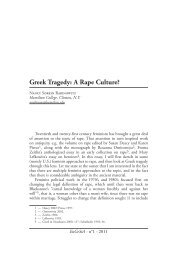Perspectives On and Of Livy's Tarpeia - EuGeStA
Perspectives On and Of Livy's Tarpeia - EuGeStA
Perspectives On and Of Livy's Tarpeia - EuGeStA
Create successful ePaper yourself
Turn your PDF publications into a flip-book with our unique Google optimized e-Paper software.
172 TaRa WeLCh<br />
characteristic (“the sort you might imitate or avoid”), Livy implies that<br />
readers must decide which examples are which. even capias puts the ball<br />
in his readers’ court: “from which you might take examples”. <strong>and</strong> does<br />
inde lead back to monumento or documenta? The readers’ work grows.<br />
My analysis here focuses on the gap between historical character<br />
(exemplum) <strong>and</strong> the reader or moral agent who would learn from it. how<br />
does historiography position the reader or viewer of an exemplum to adapt<br />
<strong>and</strong> use it? To what extent is the exemplum tranferable to other circumstances?<br />
We may return for a moment to Livy’s preface, with its emphasis<br />
on learning, discerning, <strong>and</strong> individual appropriation of the past: imitere<br />
<strong>and</strong> uites are singular verbs, not plurals, further still from generalizing<br />
passives (including periphrastics). In the next section I explore the ways<br />
Livy’s <strong>Tarpeia</strong> refuses to be pinned down as an exemplum with clear or<br />
universal meaning, <strong>and</strong> how Livy opens many paths for the reader to<br />
interpret <strong>and</strong> appropriate the story in different ways. This section focuses<br />
not on what <strong>Tarpeia</strong> herself means as an example in Livy’s text, but how<br />
her story illustrates the process, or rather a process, of reading an example<br />
from the past.<br />
Livy’s Equivocations<br />
<strong>Tarpeia</strong>’s story appears in Livy as part of the sabine cycle beginning<br />
with the Roman capture of sabine brides <strong>and</strong> ending with the joint<br />
kingship of Romulus <strong>and</strong> Tatius. The capture of the brides sparked several<br />
skirmishes between Rome <strong>and</strong> her neighbors, none notable except the<br />
battle in which Romulus won <strong>and</strong> dedicated as spolia opima to Jupiter<br />
feretrius the armor of the leader of the Caeninenses. Livy distinguishes as<br />
something different the skirmish in which <strong>Tarpeia</strong>’s treason plays a role:<br />
Nouissimum ab sabinis bellum ortum multoque id maximum fuit;<br />
nihil enim per iram aut cupiditatem actum est, nec ostenderunt bellum<br />
prius quam intulerunt. Consilio etiam additus dolus. sp. Tarpeius<br />
Romanae praeerat arci. huius filiam uirginem auro corrumpit Tatius<br />
ut armatos in arcem accipiat; aquam forte ea tum sacris extra moenia<br />
petitum ierat. accepti obrutam armis necauere, seu ut ui capta potius arx<br />
uideretur seu prodendi exempli causa ne quid usquam fidum proditori<br />
esset. additur fabula, quod uolgo sabini aureas armillas magni ponderis<br />
brachio laevo gemmatosque magna specie anulos habuerint, pepigisse<br />
eam quod in sinistris manibus haberent; eo scuta illi pro aureis donis<br />
congesta. sunt qui eam ex pacto tradendi quod in sinistris manibus esset<br />
derecto arma petisse dicant et fraude uisam agere sua ipsam peremptam<br />
mercede. Tenuere tamen arcem sabini... (1.11.5-1.12.1).



